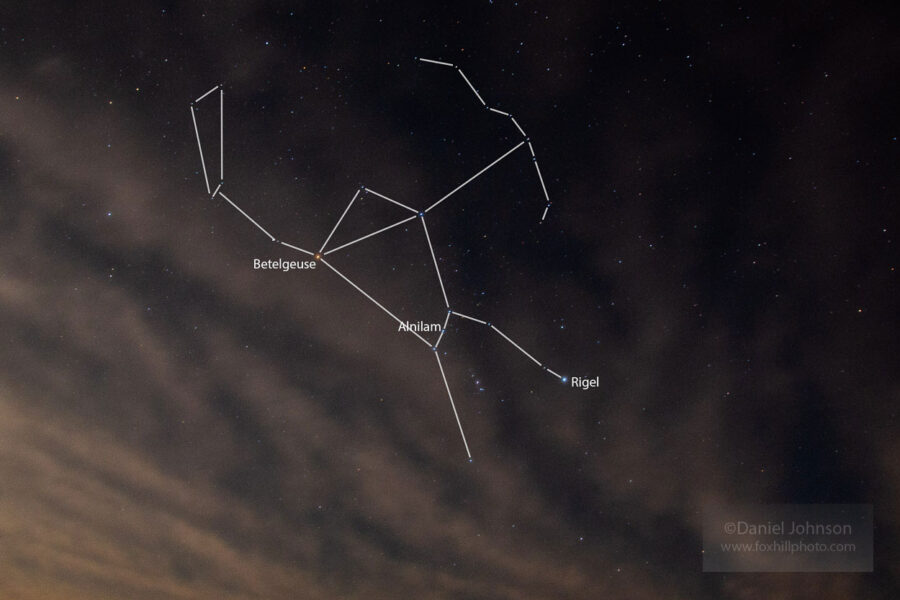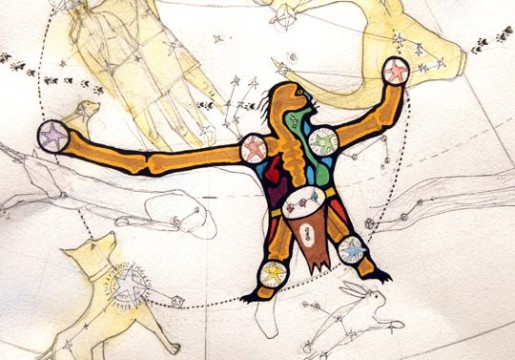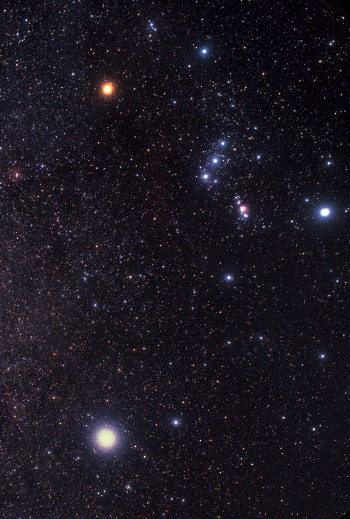Alnilam's Vitals
| Official name (IAU-approved) | Alnilam |
| Other Designations | Epsilon Orionis, HIP 26311, HR 1903, HD 37128 |
| Nicknames | - |
| Apparent Magnitude | 1.69 |
| Distance from Earth | 1,977 light-years |
| Type | Blue supergiant, B0Ia |
| Color | Blue |
| Mass | 64.5 M☉ |
| Radius | 42 R☉ |
| Constellation | Orion |
| Right Ascension | 5h 36m 12s |
| Declination | –01° 12' 07” |
| Multiple system? | No |
| Variable star? | Yes |
| Exoplanets status | None known |
| Probable fate | Supernova |
Physical Characteristics

Daniel Johnson
Alnilam is the middle star in the famous three-member belt of Orion, the Hunter. The belt is so easily recognizable because all three stars are spaced evenly in a (roughly) straight line and appear to be about the same brightness. But Alnilam stands out for being super massive, super distant, and, perhaps most intriguingly, super luminous.
Picture the Sun on a hot summer day; think about the light you see and the heat you feel. This energy is so strong that it powers photosynthesis in plants, and in turn, almost everything other living thing on Earth. Many common fuel sources ultimately derive from the Sun: gasoline, coal, natural gas, and propane, not to mention all of our wind, solar, and hydroelectricity — all of this energy would be impossible without our local star powering the processes, both now and in the past. Without the Sun, activity on Earth would slow to a frozen halt.
But now, imagine Alnilam, a star so incredibly bright that it shines with strength of over 800,000 Suns. Considering that our Sun is too bright to even look at, the luminosity of a star like Alnilam is really beyond our comprehension. All we can do is compare numbers and make analogies. Using (very) round figures, if you scaled down our Sun so that it was only as bright as the Moon, Alnilam would be as bright as the Sun is normally.
A star like Alnilam can’t output so much energy without a cost. Like the other two stars in Orion’s belt, Alnilam is a blue supergiant star, and it’s racing through its fuel source. As the fuel dwindles, Alnilam will change from blue to red and expand in size even more, but its luminosity will only increase. Ultimately, the star will end its life as a supernova, leaving a black hole in its wake.
At magnitude 1.65, Alnilam is a bright star from our perspective, but it’s only the 29th-brightest in the sky. Given that Alnilam is so powerful and emits so much light, shouldn’t it be higher up on the list? The reason is its distance: Alnilam is simply very far away. Alpha Centauri is at 4.3 light-years and Sirius is at 8.6 light-years, but Alnilam is almost 2,000 light-years away. Light follows the inverse square law, so intensity weakens as the square of the distance, which explains why Alnilam doesn’t appear as bright as it might if only we were a little closer to it.
Origin / Mythology
There is a wide-ranging consensus among cultures worldwide that Orion represents a human figure of some sort — and generally an imposing one. Greco/Roman views are of course the source for Orion’s current name and the concept that he’s a powerful hunter, with a sword hanging from his belt (the sword has a somewhat fuzzy appearance since it’s composed partly of nebula clouds). Orion is also the owner of two nearby hounds, Canis Major (with Sirius, the “Dog Star”), and Canis Minor, and the three of them are presumably chasing Lepus the Hare.

But Orion has played other roles besides the hunter. The Ojibwe culture of North America envisioned Orion as the Wintermaker. Early Arabic myths combine the stars of Orion and Gemini to form a female warrior with a bow. The female warrior was later modified into a giant, which takes Orion’s more familiar form.
In ancient Egypt, Orion was Osiris, God of the Dead, and one theory goes so far as to suggest that Orion’s belt inspired the orientation of the three major pyramids of Giza. In this concept, Alnilam would represent the middle pyramid of Khafre. In both the structures and the stars, one of the three members is slightly off-axis in relation to the other two.
However, the alignment isn’t as perfect as originally claimed: Not only is the angle not quite right, but the original study also inverted Orion’s belt to make the match work, as noted in the February 1997 Sky & Telescope. The theory therefore isn’t widely accepted.
How to See Alnilam
For many astronomers, Orion is king of the winter. It’s hard to match this brilliant constellation for size, clarity, and sheer number of bright stars, including Rigel, Betelgeuse, and Bellatrix. But it’s the three-star belt that so many people recognize as the constellation’s key feature.

In early winter, watch for the warrior/giant/hunter to begin rising in the east in the early evening; by mid-winter, he’s already high in the southeast at dusk. Orion is flanked by two nearby major stars: red Aldebaran on the upper-right and blue-white Sirius on the lower-left. Orion lies just below the ecliptic, so the Moon and planets frequently drift by above his head.
The area around Orion’s belt is rich with nebulae, including of course the Orion Nebula, as well as others that you might detect with optical aid. If you photograph the region, you’ll to find that your camera is able to distinguish the subtle pink and purple colors of the gas as well.
By the time spring rolls around, Orion disappears into the Sun’s glare, but the Wintermaker will be back around next year. Catch Alnilam soon before spring arrives!
Daniel Johnson is a Wisconsin-based freelance writer and professional photographer and the co-author of over a dozen books. He’s a longtime amateur astronomer and fortunate enough to live in a rural region with excellent seeing conditions. You can view some of Dan’s photography (he does a lot of animals!) at www.foxhillphoto.com
 4
4
Comments
PGT
March 10, 2021 at 8:22 pm
Wonderful article . . . would be good to know the translation of the name Alnilam. Arabic (?) for . . . ?
You must be logged in to post a comment.
Bob-dBouncier
March 10, 2021 at 10:03 pm
The name Alnilam is derived from the Arabic an-niżām, which means “the string of pearls.”
You must be logged in to post a comment.
Victor-Figueroa
March 13, 2021 at 8:39 am
I agree, great article written in very clear English, congratulations !! Thanks a lot.
Víctor Figueroa M
You must be logged in to post a comment.
New Jersey Eclipse Fan
March 15, 2021 at 5:35 pm
Víctor (¡con el acento!), your apellido is on my short list of surnames that contain all five vowels! My folder is on Microsoft Word, which I can't access right now, but another less common one is Cousineau. Now if your first name were only Aurelio, THAT would be very cool!
You must be logged in to post a comment.
You must be logged in to post a comment.